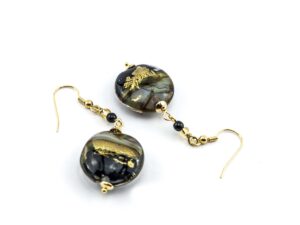“Lume”, the lamp working and how to create Murano Glass beads
The processing of lamp working is a type of processing used to create small glass objects (glass beads, small animals) using a fixed directional flame to fuse the glass, while using glass processing tools and gravity to shape the piece.
The principle of “lume” processing is that it allows to soften a glass barrel over a flame of a live fire, making the glass reach a temperature of more than 700 degrees, such as to make it “soft”, malleable and transformable in the shapes designed by the artist. The temperature is reached thanks to the use of a flame made from the simultaneous supply of methane and oxygen.
Using various techniques and glass rods of different colors, the possibilities of design, decorations and colors become countless. After the completion of the process, the pearl cools slowly and evenly, thus avoiding possible ruptures due to tensions within the pearl itself.
These small handmade pieces are the most time-consuming method of making glass beads, since each pearl of art is made individually on a flame, each resulting in a handmade, labor-intensive, but unique piece of art.
The processing of “light” glass has very ancient origins and was practiced since 3500 BC in Egypt and Mesopotamia. Since that time, glass beads have been an important part of the cultural history of humanity. In the ancient world they served, not only as decorations, but also as a means of exchange or payment as well as “status symbol”.
The first glass beads produced in the Mediterranean began in 2000 BC. Particularly on the island of Murano/Venice, from the 13th century, knowledge of glass processing from the East was developed. From that time the glass beads were exported, as a luxury asset and became famous all over the world. Even today, many of the glass used for the production of pearls come from Murano and the traditional processing technique has remained basically the same as thousands of years ago.



Murano Glass Bijoux uses the following procedures:
Glass pearls with adventure
The “adventure” glass is a particular workmanship of Murano glass. At the time of the creation of the glass, copper scales are added to it that make the glass mass bright and bright as if it had gold straws inside it.
Murano glass pearls with gold leaf or silver leaf
Gold leaf and silver leaf are used in the processing of the “submerged gold” and “silver submerged”, imprisoning in the glowing glass of the very thin 24k gold or pure silver slips.
Blown glass pearls
The blowing is one of the oldest and characteristic processing of glass. After being processed, the glass mass is “blown” by the glass master through a metal “straw”, up to the desired size. Blown glass beads are the most delicate and difficult beads to be produced.

